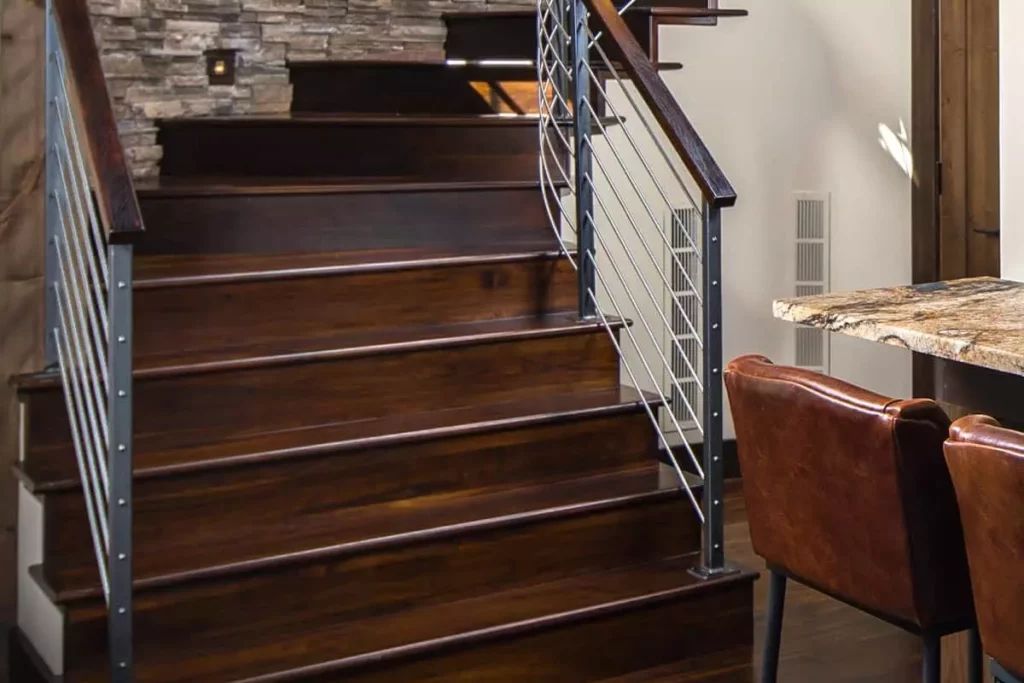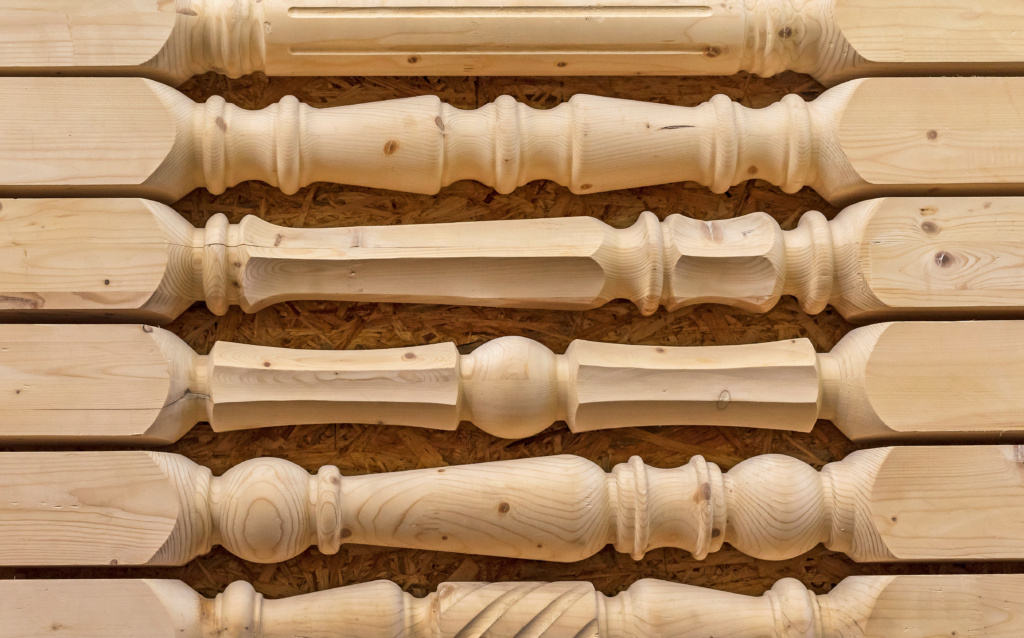
Step Up Your Stair Game: A Comprehensive Guide to Wood Stair Parts
A well-designed staircase can transform an ordinary area into a stunning focal point that adds value to any property. From the grandeur of a sweeping spiral staircase to the simplicity of a straight flight of stairs, every detail counts in creating a staircase that is both visually appealing and practical.
In this blog, we will explore the different types of wood stair parts, their functions, and how to choose the right ones for your staircase. Whether you are building a new staircase or renovating an existing one, understanding the anatomy of wooden stairs will help you make informed decisions that will result in a beautiful and functional staircase for years to come.
#1 – Wood Stair Parts: Stair Treads
Stair treads are the horizontal components of a staircase that provide a walking surface for ascending or descending the stairs. They come in a variety of materials, but wooden stair treads are a popular choice due to their durability and natural beauty.
Solid wood treads are the traditional choice for wooden staircases. They’re made from a single piece of wood and offer a classic look that can be customized with different finishes and stains. Engineered wood treads, on the other hand, are made from layers of wood veneer that are glued together to create a strong and stable tread. These wood stair parts are often more affordable than solid wood and can be made to mimic the look of a solid wood tread.
If the stairs will be used frequently, solid wood treads may be the better choice, as they are more durable and can be refinished multiple times. However, if the stairs will be used less often, an engineered wood tread may be a more cost-effective option.
Best Wood For Stairs Treads
This is a common question. A lot of people don’t think of the whole stair structure when you mention the word “stairs,” but instead they think of stair treads, as those are what you fix your gaze on as you are ascending or descending a staircase. They are oftentimes the most noticeable aspect of a stair structure and because of that, material choice and aesthetics play a big role.
Among the top choices, hardwoods such as oak, maple, and cherry stand out as popular options.
- Oak, renowned for its strength and resilience, is a frequent choice due to its ability to resist wear and tear. It has natural resistance to damage from impacts, making it less susceptible to dents and scratches. This characteristic is particularly important for stair treads, which endure constant use and potential stress.
- Maple, with its light color and tight grain, offers a sleek and modern appearance while maintaining durability. Maple also takes finishes and stains well, allowing for various customization options. Whether you prefer a natural, clear finish to highlight the wood’s natural beauty or a stained finish to match your interior decor, maple can be adapted to achieve the desired look.
- Cherry, on the other hand, adds a touch of warmth and richness to the staircase, blending elegance with sturdiness. Cherry wood undergoes a natural aging process, darkening and developing a deeper patina over time. This aging process adds character to the wood and enhances its visual allure, making it an excellent choice for those who appreciate the evolving beauty of natural materials.
These hardwoods excel in handling the constant traffic associated with stairs, ensuring longevity and minimizing the effects of everyday use. Additionally, their versatile finishes allow for customization to complement various interior styles, making them the best choices for both functionality and aesthetics in stair tread applications.
If you’re still wondering if there is a single species of wood that is best for stair treads, the simple answer is no. But there may be one that is best suited for your home.
As you think about which material will work best, consider what you most want from wood stair treads. Is it durability, is it the look, or does it have to do more with what’s most affordable? The answer to that question should help guide your decision.
#2 – Wood Stair Parts: Stair Risers
As you ascend a flight of stairs, you may not give much thought to the vertical stair part that makes up each step—the stair risers. But these unassuming stair parts play a crucial role in the overall structure and aesthetics of a staircase.
Stair risers can come in a variety of types, from the classic closed riser that fully encloses the vertical space between steps, to the sleek open riser that exposes the empty space beneath each step.
So, which type of stair riser is right for you? The closed riser offers a traditional and safe option, fully enclosing the space between steps and providing added stability. However, the open riser can create a modern and minimalist look, allowing light and air to flow freely between each step. The stair risers give homeowners the opportunity to show off their unique style and add character to a staircase.
#3 – Wood Stair Parts: Landing Tread
In simple terms, the landing tread is the horizontal surface that forms a platform at the top of a flight of stairs, providing a stable and secure footing for users while also offering an aesthetic break between levels.
The landing tread’s significance extends beyond its practical purpose, as it can also be a reflection of your style and creativity. With different materials available, including classic hardwood, sleek glass, and sturdy metal, the landing tread can be customized to match your personal taste and functional requirements. Of course, we’re partial to wood stair parts for landing tread.
What is the difference between a tread and a riser?
When discussing wood stair parts, it’s important to know the difference between the landing tread and riser. The flat area you walk on when climbing or descending stairs is called the stair landing tread. The riser, on the other hand, is the vertical portion between each tread and determines the height of the staircase. Risers contribute to the safety of the staircase by sealing the spaces between the steps, whereas treads are just meant to give a firm step. Treads and risers work together to ensure the safety and style of your staircase.
#4 – Wood Stair Parts: Balusters
Now, let’s talk about balusters—the unsung heroes of stair design. Balusters are the vertical supports that run between the stair treads and the handrail, forming the safety barrier that keeps you and your guests from taking a tumble down the stairs.
So, how do you choose the right type of baluster for your stair design? First and foremost, safety should be a top priority, so consider the strength and durability of the material you choose. You don’t want to compromise safety for style.
Secondly, think about the overall look and feel you want to achieve with your stairs. Do you want a classic and timeless look with wooden balusters, or do you want to create a modern and sophisticated feel with sleek glass or metal balusters? Your choice of baluster can make a significant impact on the overall aesthetic of your staircase.
Lastly, consider your budget and maintenance preferences. Some materials may require more upkeep than others, and some may come with a higher price tag. You want to choose a baluster that not only looks great but also fits within your budget and maintenance capabilities.
#5 – Wood Stair Parts: Newels
Newels may or may not be wood stair parts that you have heard of before. Newels are the sturdy posts at the bottom and top of your staircase, providing support and adding a touch of grandeur to your stair design. Newels come in different types, including box and turned newels, and each offers a unique design element to your staircase. Box newels are rectangular posts that offer a more modern and sleek look, while turned newels are round posts with ornate details that add a classic and elegant feel to your staircase.
#6 – Wood Stair Parts: Wooden Handrails
Let’s get a grip on what handrails actually are. Handrails are the sturdy, supportive structures that are mounted along staircases, balconies, and other raised areas to provide balance and prevent falls. They are integral when it comes to stair parts.
Straight handrails are the most common type, providing a simple and sleek look that complements any style of home. Meanwhile, curved handrails offer a more elegant and sophisticated touch, perfect for those looking to add a touch of luxury to their living space. And let’s not forget about the variety of wooden handrails available. From classic oak to rustic cherry, wooden handrails offer a warm and inviting feel that is sure to impress.
But why choose wooden handrails over other materials? For starters, wooden handrails are incredibly durable and long-lasting. Unlike other materials that may crack or warp over time, wooden handrails are designed to withstand wear and tear while maintaining their beauty. Additionally, wooden handrails are naturally resistant to moisture, making them ideal for outdoor areas or humid climates.
#7 – Wood Stair Parts: Starting Steps
The importance of starting steps cannot be overstated when it comes to what stair parts are definitely needed. They serve as the foundation for the rest of the stairs and help ensure a safe and seamless transition between the floor and the first step.
When it comes to materials, the options for starting steps are practically endless. For a classic and timeless look, hardwood starting steps are a popular choice. Oak, cherry, and walnut are all popular choices for their durability and beauty.
The Final Step: Wrapping Up Your Wood Stair Parts Journey
If you’re looking to buy wood stair parts for your next home improvement project, look no further than Reliance Timber. Our team produces high-quality stair parts under rigorous standards, and we can deliver them directly to your job site. Get in touch with us today to learn more about our products and services.










